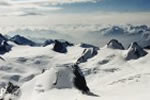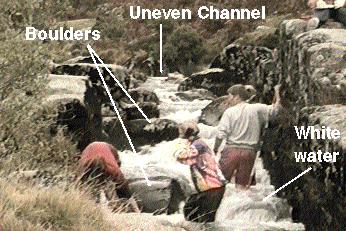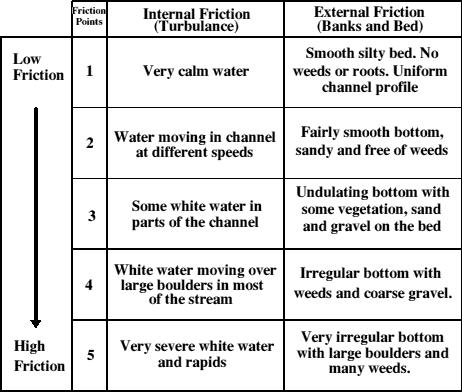


 |
 |
 |
![]() Introduction
Introduction
![]() Internal
Friction
Internal
Friction
![]() External
Friction
External
Friction
![]() Friction
Table
Friction
Table
Water is often considered to be a lubricant, so the idea of friction within a river is not always obvious to new geographers.
When two touching items move past each other there will be friction. In a river the most obvious moving item is water. As the water flows over the bed and banks of the river it experiences friction in the form of drag. At the water surface there is friction generated by air moving across the water.
The shaping and characteristics
of a river owe much to the action of friction. The channel shape, water velocity
and even vegetation of a river are linked to the amount of friction present.
It is a complex relationship; the amount of friction alters the character of
the river, yet the character of the river also determines the amount of friction.
The frictional forces acting in a river are divided into two types, Internal
and External, based on where the friction
occurs.
Internal friction is also known as turbulence. It can be visually estimated by looking at the river and deciding how calm or rough the flow seems. Very calm water indicates very little friction whereas fast flowing white water and rapids is a clear indication of considerable friction within the river. This way of estimating friction is not particularly scientific, there are no fixed numbers to measure, just the observer's opinion. This is known as subjective data,ie, it relies on just your observations. The observed friction can be described by giving a different number of friction points according to the roughness of the water; 1 for very calm water, up to 5 for white water rapids. You might find it useful to use a Friction Table when making these measurements in the field. It will act as a reminder of the number of friction points to be given and will also help to standardise the observations you, and others, make.
This is the friction resulting from the water touching the bed and banks of the river. When the water touches the sides of the channel it is slowed down. The amount of friction depends upon the nature of the bed, banks and shape of the channel. A very smooth channel with no protruding rocks, tree roots or boulders will create low frictional drag. The surface will appear calm and there will be no white water.

A very rough, angular channel with large boulders and tree roots strewn across it's bed will appear turbulent. Flow will seem rapid and there will probably be white water.

As the channel becomes more rough, so the length of the channel cross-section, called the wetted perimeter, increases. Imagine a river bed with a perfectly flat bed and vertical banks, and another of the same size but with large boulders across the bed, and rocks sticking out of the banks. If we measured the length of the area under water from one side of the river to the other we would get the wetted perimeter. It will be longer for the river with the boulders because we have to measure up and down each bump instead of straight across the flat bed.
Because the amount of bed and banks exposed to the flowing water has increased the amount of friction generated will also increase. More surface for the water to flow over gives more external friction.
You might find it useful to use a Friction Table when making these measurements in the field.

We value
your ideas and suggestions. Please contact the
maintainer of this site.
This page
can be found at: http://www.geography-site.co.uk
Last update to
this statement was on:
February 20, 2006
© Copyright Geography Site